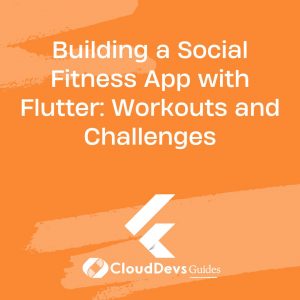Building a Social Fitness App with Flutter: Workouts and Challenges
Flutter provides a versatile framework for building cross-platform apps with a single codebase. This article explores how you can leverage Flutter to create a social fitness app that not only tracks workouts and sets challenges but also fosters community engagement.
Understanding the Concept of a Social Fitness App
A social fitness app combines workout tracking with social features, allowing users to connect, share their progress, and participate in fitness challenges. Such apps help users stay motivated and engaged by providing a platform for social interaction and personal achievement.
Building a Social Fitness App with Flutter
Flutter’s rich set of widgets and plugins makes it an excellent choice for developing a feature-rich social fitness app. Here are key aspects and examples of how to implement workout tracking, challenges, and social features using Flutter.
1. Implementing Workout Tracking
Tracking workouts is a core feature of any fitness app. Flutter provides several packages and tools to facilitate this.
Example: Using the [Flutter Health](https://pub.dev/packages/flutter_health) Package
- Add the Package to Your Project
Include the Flutter Health package in your `pubspec.yaml` file to access health and fitness data.
- Request Permissions
Request necessary permissions from users to access health data on both Android and iOS.
- Track Workouts
Use the package’s API to record and retrieve workout data, such as exercise type, duration, and intensity.
2. Setting Up Fitness Challenges
Fitness challenges encourage user participation and engagement. Implementing this feature requires creating a system for users to join and compete in challenges.
Example: Creating Challenges with a [Firestore Database](https://firebase.google.com/docs/firestore)
- Set Up Firestore
Integrate Firestore into your Flutter project to manage challenge data.
- Design Challenge Structures
Define challenge types, rules, and rewards. Create Firestore collections to store challenges and user participation data.
- Display Challenges
Build UI components to display active challenges, allow users to join, and track their progress.
3. Integrating Social Features
Social features enhance user interaction and foster a sense of community within your app. These can include user profiles, friend connections, and activity feeds.
Example: Using the [Firebase Authentication](https://firebase.google.com/docs/auth) and [Cloud Firestore](https://firebase.google.com/docs/firestore) for Social Features
- Set Up Firebase Authentication
Implement user authentication to enable users to create accounts, log in, and manage their profiles.
- Create User Profiles
Use Cloud Firestore to store and retrieve user profile information, including fitness achievements and social connections.
- Build Social Components
Develop features like friend requests, activity feeds, and messaging to enhance social interactions within your app.
4. Enhancing User Experience with Data Visualization
Visualizing workout data and challenge progress helps users understand their achievements and stay motivated. Flutter supports various charting libraries for this purpose.
Example: Integrating with [fl_chart](https://pub.dev/packages/fl_chart) Library
- Add fl_chart to Your Project
Include the fl_chart package in your `pubspec.yaml` file to create charts and graphs.
- Design Charts
Use the package to create line charts, bar charts, or pie charts to represent workout data, challenge progress, or user statistics.
- Display Charts in Your App
Integrate the charts into your app’s UI to provide users with visual insights into their fitness journey.
Conclusion
Building a social fitness app with Flutter involves implementing key features like workout tracking, fitness challenges, and social interactions. By leveraging Flutter’s powerful capabilities and integrating with services like Firebase and charting libraries, you can create a comprehensive and engaging fitness experience for users.
Further Reading:
Table of Contents








